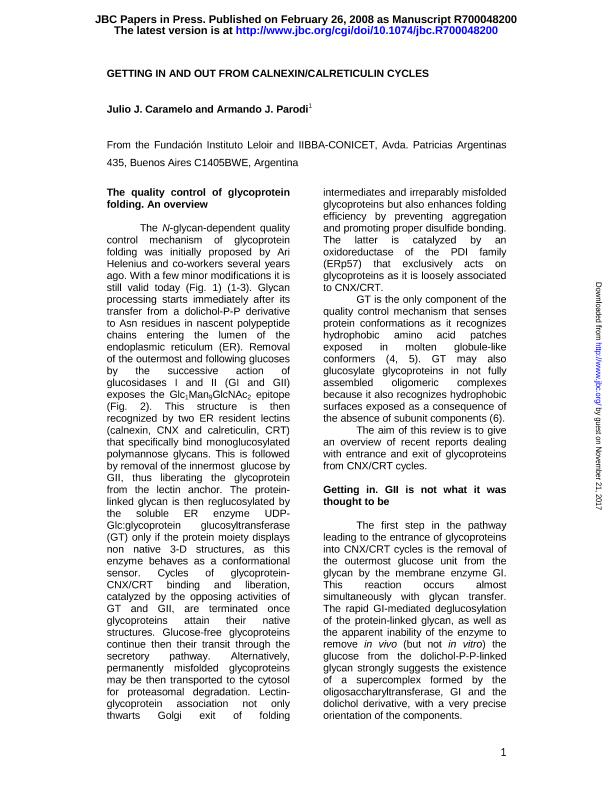Mostrar el registro sencillo del ítem
dc.contributor.author
Caramelo, Julio Javier

dc.contributor.author
Parodi, Armando José A.

dc.date.available
2017-11-21T19:15:59Z
dc.date.issued
2008-02
dc.identifier.citation
Caramelo, Julio Javier; Parodi, Armando José A.; Getting in and out from calnexin/calreticulin cycles; American Society for Biochemistry and Molecular Biology; Journal of Biological Chemistry (online); 283; 16; 2-2008; 10221-10225
dc.identifier.issn
0021-9258
dc.identifier.uri
http://hdl.handle.net/11336/28665
dc.description.abstract
The N-glycan-dependent quality control mechanism of glycoprotein folding was proposed initially by Helenius and coworkers several years ago; with a few minor modifications, it is still valid today (Fig. 1) (1–3).2 Glycan processing starts immediately after its transfer from a dolichol-P-P derivative to Asn residues in nascent polypeptide chains entering the lumen of the ER.3 Removal of the outermost and following glucoses by the successive action of GI and GII exposes the Glc1Man9GlcNAc2 epitope (Fig. 2). This structure is then recognized by two ER resident lectins (CNX and CRT) that specifically bind monoglucosylated polymannose glycans. This is followed by removal of the innermost glucose by GII, thus liberating the glycoprotein from the lectin anchor. The proteinlinked glycan is then reglucosylated by the soluble ER enzyme GTonly if the protein moiety displays non-native three-dimensional structures, as this enzyme behaves as a conformational sensor. Cycles of CNX/CRT-glycoprotein binding and liberation, catalyzed by the opposing activities of GT and GII, are terminated once glycoproteins attain their native structures. Glucose-free glycoproteins then continue their transit through the secretory pathway. Alternatively, permanently misfolded glycoproteins may be then transported to the cytosol for proteasomal degradation. Lectin-glycoprotein association not only thwarts Golgi exit of folding intermediates and irreparably misfolded glycoproteins but also enhances folding efficiency by preventing aggregation and promoting proper disulfide bonding. The latter is catalyzed by an oxidoreductase of the proteindisulfide isomerase family (ERp57) that acts exclusively on glycoproteins, as it is loosely associated with CNX/CRT
dc.format
application/pdf
dc.language.iso
eng
dc.publisher
American Society for Biochemistry and Molecular Biology

dc.rights
info:eu-repo/semantics/openAccess
dc.rights.uri
https://creativecommons.org/licenses/by-nc-sa/2.5/ar/
dc.subject
Udp-Glc:Glicoproteína Glucosiltransferasa
dc.subject
Calreticulina
dc.subject.classification
Otras Ciencias Químicas

dc.subject.classification
Ciencias Químicas

dc.subject.classification
CIENCIAS NATURALES Y EXACTAS

dc.title
Getting in and out from calnexin/calreticulin cycles
dc.type
info:eu-repo/semantics/article
dc.type
info:ar-repo/semantics/artículo
dc.type
info:eu-repo/semantics/publishedVersion
dc.date.updated
2017-11-16T15:08:12Z
dc.identifier.eissn
1083-351X
dc.journal.volume
283
dc.journal.number
16
dc.journal.pagination
10221-10225
dc.journal.pais
Estados Unidos

dc.journal.ciudad
Baltimore
dc.description.fil
Fil: Caramelo, Julio Javier. Consejo Nacional de Investigaciones Científicas y Técnicas. Oficina de Coordinación Administrativa Parque Centenario. Instituto de Investigaciones Bioquímicas de Buenos Aires. Fundación Instituto Leloir. Instituto de Investigaciones Bioquímicas de Buenos Aires; Argentina
dc.description.fil
Fil: Parodi, Armando José A.. Consejo Nacional de Investigaciones Científicas y Técnicas. Oficina de Coordinación Administrativa Parque Centenario. Instituto de Investigaciones Bioquímicas de Buenos Aires. Fundación Instituto Leloir. Instituto de Investigaciones Bioquímicas de Buenos Aires; Argentina
dc.journal.title
Journal of Biological Chemistry (online)

dc.relation.alternativeid
info:eu-repo/semantics/altIdentifier/url/http://www.jbc.org/content/283/16/10221.long
dc.relation.alternativeid
info:eu-repo/semantics/altIdentifier/hdl/https://doi.org/10.1074/jbc.R700048200
Archivos asociados
